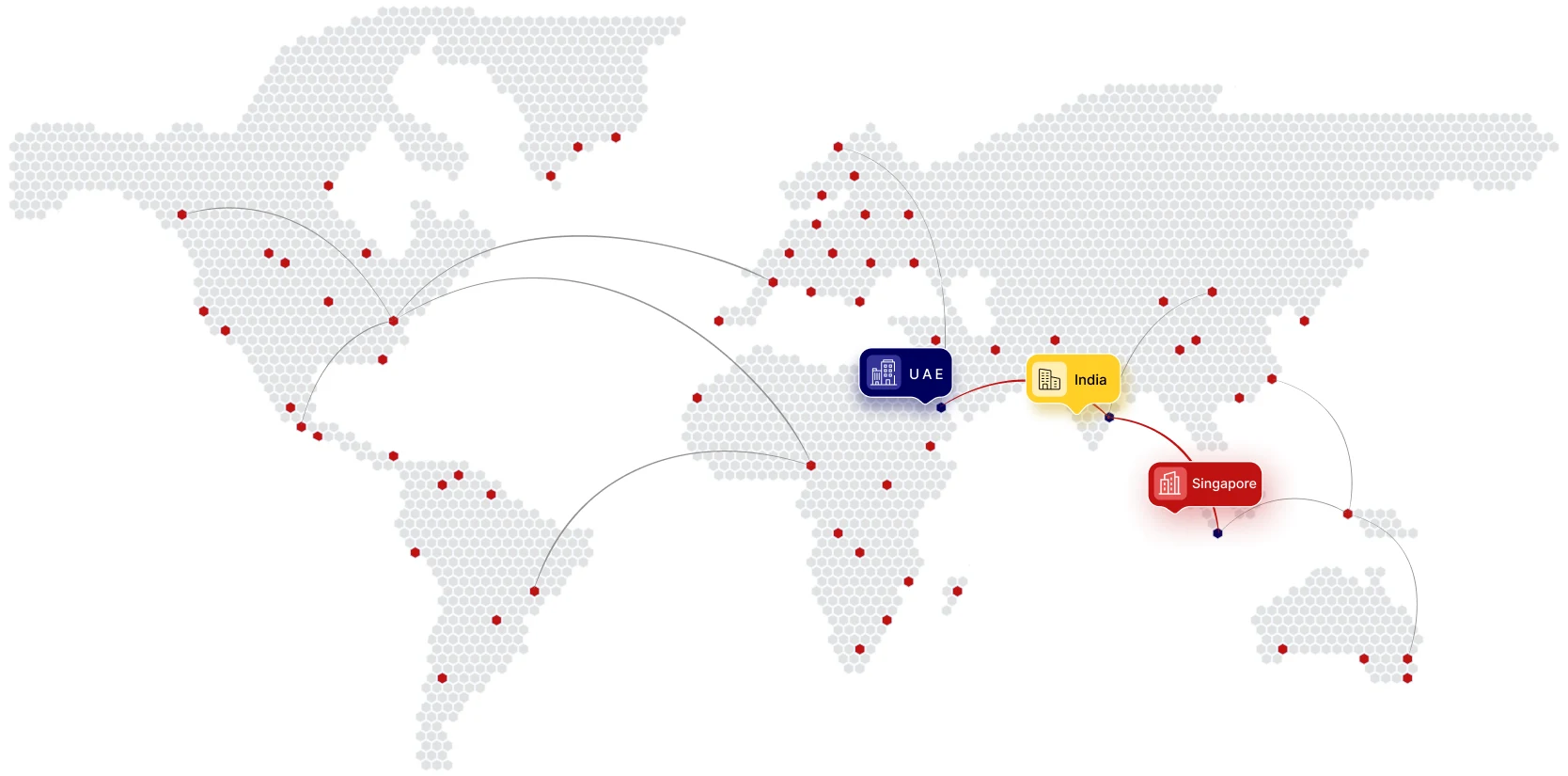
- NEWSLETTER,U.A.E
- November 10, 2023
The IMC focuses on the criteria for attaining Qualifying Free Zone Person status in various jurisdictions in the context of global business and corporate tax regulations.
Under the global corporate tax guidelines, Qualifying Free Zone Persons can benefit from a preferential 9% corporate tax rate on their Qualifying Income. However, they need to fulfil the following conditions:
- Establishing a substantial presence within the designated free zone
- Generating Qualifying Income
- Adhering to the Transfer Pricing documentation and Arm’s Length Principle
- Ensuring that non-qualifying revenues remain below specified de-minimis thresholds
- Compiling audited Financial Statements as per local laws
- Fulfilling any additional conditions that the relevant authorities need
Key Insights
With the calendar year drawing to a close in 2023, businesses operating within free zones, with their initial tax periods commencing on or after January 1, 2024, should prioritize evaluating their operations to be eligible for the preferential corporate tax regime (i.e., a 9% corporate tax rate) as applicable.
It is imperative to carry out strategic planning and an early assessment to ensure that businesses meet all the conditions from the very beginning. It takes time to implement any restructuring, resource allocation, adjust processes, or evaluate potential benefits.
Certain steps may be more urgent or important compared to others to ensure compliance from the first day. Taking timely action after identifying those steps holds the key to enjoying the 9% benefit.
Disclaimer

- Article, Global
- November 6, 2023
In today’s digital era, businesses are constantly in pursuit of methods to streamline their operations, boost productivity, and elevate client satisfaction. Among the notable instruments that have made a substantial impact in the business landscape is Zoho.
Zoho offers extensive business tools that operate synergistically, providing a comprehensive solution to your business requirements. Whether your objectives involve client management, inventory oversight, data analysis, or digital document signing, Zoho is well-equipped to meet your needs. In this article, we will delve into how Zoho can potentially transform any business.
Understanding Zoho
What is Zoho?
Optimizing Operations
Enhancing Efficiency with Zoho CRM
Effective Project Management
Boosting Productivity
Fostering Collaboration and Communication
Automation through Zoho Workflow
Enhancing Client Satisfaction
Tailored Client Support
Marketing Insights
Zoho Marketing Hub equips businesses with valuable insights into their marketing campaigns. Companies can customize their marketing strategies to maximize customer engagement and conversions by comprehending customer behaviour and preferences.
Whether the goal is operational streamlining, productivity enhancement, or the elevation of client satisfaction, Zoho stands as a versatile platform that can adapt to the distinct requirements of each business.
Let’s embark on a journey across ten diverse business sectors to witness how Zoho can simplify your operations. Prepare to explore how Zoho can streamline your business, irrespective of your industry. To find a solution, it’s important to work smarter, not harder.
Real Estate
Zoho CRM
Zoho Sign
Zoho Social
Manufacturing
Zoho Inventory
Zoho CRM
Zoho Analytics
Zoho People
Legal Services
Zoho CRM
Zoho WorkDrive
Zoho People
Media and Entertainment
Zoho Backstage
Zoho Projects
Zoho CRM
Finance and Banking
Zoho Analytics
Zoho CRM
Zoho Vault
Travel and Hospitality
Zoho CRM
Zoho Desk
Zoho Campaigns
Zoho Expense
Nonprofit
Zoho CRM
Zoho Creator
Zoho Books
This tool facilitates cost control, financial monitoring, and transparent reporting, ensuring accountability. Additionally, we offer cloud accounting services through Zoho Books.
Zoho People
Software Development
Zoho Sprints
Zoho Developer
Education
Zoho Classes
Zoho CRM
Zoho Office Suite
Zoho People
Agriculture
Zoho Inventory
Zoho CRM
Zoho Analytics
Embarking on your journey with Zoho may seem intricate initially. Nevertheless, you are primed for triumph with xponential Digital as your devoted Zoho Consulting Partner. It specializes in the precise adaptation and enhancement of the Zoho platform to align with sector-specific requisites. Elevate your operational excellence with Zoho, guided by the expertise of xponential Digital.

- Article, Global
- October 19, 2023
Understanding Risk Management
Defining Risk Management
The Components of Risk Management
1. Risk Identification
2. Risk Assessment
3. Risk Mitigation
4. Risk Monitoring and Review
The Significance of Risk Management
1. Safeguarding Financial Stability
2. Enhancing Decision-Making
3. Compliance and Reputation
The ROI of Risk Management
Cost Savings
Competitive Advantage
Long-Term Sustainability
Conclusion
FAQs
Is risk management only for large corporations?
How often should risk management strategies be reviewed?
Can risk management completely eliminate all risks?
Is risk management only about financial risks?
How can I get started with risk management for my organization?

- NEWSLETTER, GLOBAL
- October 10, 2023
In recent years, Environmental, Social, and Governance (ESG) considerations have taken centre stage in corporate boardrooms. ESG has gone a long way in shaping the way businesses operate and make decisions. However, it’s equally crucial to understand the profound impact of ESG practices on entry level enterprises, from the C-suite to middle management and operational roles.
Let’s explore the concept of role-based ESG and how businesses are transforming by embracing this concept. As a business owner or CEO, it’s imperative to understand the wide range of benefits of role-based ESG.
The Hidden Potential of Employee-Driven ESG Initiatives
It’s not uncommon for employees within an organization to make substantial contributions to ESG goals. This can be as simple as sharing rides, reducing single-use plastic, using public transportation, or cycling to work. However, data capturing these individual efforts often goes unnoticed.
Many businesses can relate themselves to this situation where they are taking meaningful strides towards achieving sustainability and net-zero goals. However, they fail to communicate the impact of these actions effectively throughout the organization.
Sustainability reporting has reached an all-time high in the corporate world. As much as 96% of S&P 500 and Russell 1000 companies currently publish their ESG reports. Despite these strides, the influence of ESG initiatives on the average employee remains largely unexplored. Adopting role-based ESG practices is the key to addressing this gap where data integrity lies at its core.
Cultivating a Data-Centric Culture for Role-Based ESG
Businesses need to foster a data-centric culture throughout their organization to implement role-based ESG effectively. Leadership teams are gradually increasingly recognizing the importance of this shift. However, the key challenge lies in engaging employees at different levels of the organization to embrace this approach.
Now, organizations face a question: How do they inspire a ‘we want to do this’ attitude driven by employees rather than a ‘we should do this’ directive from the top?
In this case, the solution lies in capitalizing on qualitative data to validate the actions of employees. When individuals see that their efforts are recognized and contribute to decision-making processes, chances are high that they will engage wholeheartedly. With this approach, there’s limited risk that employees would perceive ESG efforts as mere lip service, a perception that often leads to disengagement.
Organizations can empower individuals by capturing data using different tasks and sharing the results transparently across the company. This provides adequate proof of concept for their actions. The approach is effective in encouraging a data-centric culture while measuring the results simultaneously. This brings about a real change and fosters a sense of empowerment among employees.
Role-Based ESG as a Catalyst for Employee Satisfaction and Social Responsibility
Employees need not fear the adoption of role-based ESG strategies. Companies should assign ESG-related tasks and responsibilities across various roles to cultivate a culture of sustainability and social responsibility. With this approach, they can succeed in delivering a greater degree of job satisfaction and boost the morale of employees, who realize that their efforts eventually have a broader and positive impact on society.
However, companies must adopt a thoughtful stance while implementing these strategies. For each role, ESG responsibilities should be integrated in a manageable and relevant manner. Therefore, organizations must provide relevant resources to their employees, including training, support, and adequate data. This ensures that employees can contribute to the ESG goals of the organization effectively.
Ensuring Authenticity in Role-Based ESG
Fostering a Community of Best Practices
Capturing workforce contributions is crucial to improve and support ESG best practices continually. This can help in shaping and driving the evolution of ESG standards across the organization. Creating a community to share best practices holds immense potential in strengthening ESG efforts. Therefore, a role-based approach to ESG should span every level of an organization to elicit a transformative impact. Businesses embracing this approach can enhance risk management, enhance their reputation and boost profitability.
Eventually, organizations shouldn’t consider ESG to be a niche concern for their boardrooms. It’s a strategic component in every forward-thinking enterprise.

- NEWSLETTER, GLOBAL
- October 10, 2023
Expanding your workforce globally is a strategic move to set your business on a growth trajectory, boosting productivity. However, the success of your ambitious venture largely hinges on your ability to understand the principles of global payroll compliance. There’s no point in having a global workforce if you can’t pay them accurately and compliantly, right? Therefore, efficient management of an international payroll is imperative for your business to capitalize on the full potential of your global team and drive sustainable growth. No wonder why successful organizations count on specialized companies for global payroll solutions as they scale globally.
For any business expanding internationally, global payroll management appears to be a formidable challenge. From multifaceted compliance requirements to complex tax regulations, the norms keep varying between different countries. Your organization needs to take on these challenges head-on to fully benefit from the untapped growth opportunities and maximize the potential of a global workforce.
5 Key Global Payroll Challenges for Your Organization
1. Understanding Local Tax Laws and Regulations
2. Categorizing Workers
3. Policies to Protect Data
4. Payment Currency
5. Providing Benefits to Employees
How To Overcome Global Payroll Challenges?
1. Outsource Global Payroll Services
2. Employer of Record (EOR)
3. Shadow Payroll System
Outsource Global Payroll Services to Dedicated Teams
With competition raging high in the global business ecosystem, why let payroll compliance impede your growth? Addressing the top global payroll challenges and outsourcing global payroll services, shadow payroll systems, and EOR services can put you on track. The IMC Group offers comprehensive EOR and PEO services to businesses expanding globally, streamlining their compliance process and boosting their efficiency. With professional assistance from our end, you can capitalize on the wealth of a global workforce while ensuring compliance.

- NEWSLETTER, GLOBAL
- October 10, 2023
The steadfast motivation of startups, along with their creative edge and innovative spirit, defines their secret to success in a competitive business ecosystem. Amidst all this enthusiasm, it’s imperative for startups to cultivate a robust culture of governance risk management and compliance. Prioritizing long-term viability and success, these budding organizations should establish these pillars at the outset, particularly in a competitive business environment.
Walking in the shoes of a startup owner or CEO, it pays to know the best practices to ensure proper governance within the startup ecosystem.
Evaluating The State of Governance in Startups
Which areas should startups focus on?
Startups need to prioritize governance, resilience, and financial metrics to remain on the right track. In this regard, a holistic perspective is necessary for startups, where these organizations need to prioritize financial metrics, governance, and operational resilience. They should also consider valuations and factors like integrity, governance, and compliance.
For startups, it’s crucial to strike a balance between growth and profitability while integrating various metrics to ensure sustainable success.
Balancing Governance with Entrepreneurial Spirit
Forward-thinking organizations, including startups, must adopt a strategic stance to balance their freedom to operate independently with governance. While the primary emphasis lies on identifying entrepreneurs with a strong vision, the equation should also have a proper equilibrium between entrepreneurial spirits and corporate governance.
It’s wise to seek enterprise risk management solutions from professional experts who carry out due diligence and evaluate aspects like compliance, operations, and integrity. With professionalism on your side, you can maintain this balance.
Driving Governance with Top Talent
Analyzing funding considerations and investor outlook
Due Diligence Before Investing and Red Flags
In the context of ensuring governance, it should be noted that startups need to work on pre-investment due diligence seriously. The focus should lie on solid unit economics, a robust business thesis, and a well-defined path leading to profitability.
The due diligence process might also reveal certain red flags. This can trigger further investigation or even lead to the withdrawal of investment.
ESG Risks and The Role of Forensic Services
The role of forensic services in due diligence is vital, and this includes commercial, operational, and financial aspects. Startups need to evaluate ESG (Environmental, Social, and Governance) risks stringently. This also points to the importance of governance in the sustainability and evaluation of upcoming organizations. Established companies like the IMC Group specialize in providing GRC insights for industry-specific regulations.
Cybersecurity and Data Privacy Risks
The significance of data privacy and cybersecurity risks in a rapidly digitizing business ecosystem is crucial for startups. These organizations should prioritize data security to remain on the top.
Established companies like the IMC Group specialize in providing due diligence services and audits, besides addressing cybersecurity concerns for startups. While the startup ecosystem looks dynamic, seeking professional consultation to ensure sound governance is the need of the hour.

- NEWSLETTER,SINGAPORE
- October 10, 2023
Singapore has long held its status as a premier destination for international companies. Whether it’s an international expansion or setting up company headquarters, the country has been the focal point for commercial ventures across ASEAN and Asia. The favorable legal and tax regimes largely shape the country’s status as a preferred investment destination in Asia. Singapore boasts a highly integrated financial system, besides being one of the most investor and business-friendly countries in the world. Forward-thinking businesses rightly seek professional assistance for company formation in Singapore to fast-track the process.
Singapore’s financial system is deeply integrated with the global market, positioning the country as a strategic gateway to some of the largest combined free trade areas through ASEAN. This includes free trade agreements (FTAs) in ASEAN-Hong Kong, ASEAN-China, and ASEAN-India.
However, there’s much more for businesses in store in Singapore beyond financial perks and tax incentives. Let’s explore the aspects that make Singapore an ideal destination for businesses.
The Geographic Advantage
Singapore boasts a prime location in the heart of Southeast Asia, located between Indonesia and Malaysia. This strategic positioning provides seamless access to transport and trade links across the region. Being centrally located, Singapore continues to be an alluring destination to some of the most rapidly expanding and vibrant markets of the world.
For investors looking forward to capitalizing on the opportunities in the ASEAN markets, Singapore offers a seamless pathway to business. Thanks to its competitive tax environment, efficient setup procedures, and seamless supply chains, the country stands out as a global destination for investment. In recent years, Singapore has even surpassed traditional regional choices like Malaysia.
Interestingly, the Port of Singapore ranks among the best-connected and busiest global seaports. It connects 120 countries through more than 600 ports across the world. Besides, the Singapore Changi Airport continues to be one of the largest transport hubs in Asia. It handles more than 68 million passengers and over two million tons of air freight annually.
Singapore’s multicultural society, with various cultural and linguistic connections to ASEAN members, delivers a strategic advantage to the country. In Singapore, English is the primary working language. This fosters effective communication with investors from all over the world.
The highly skilled local workforce in Singapore acts as intermediaries for investments in Asia. This ensures a smooth market entry for international businesses, along with optimal profit maximization. No wonder, why Singapore continues to strengthen its position as a key business and management hub in Southeast Asia.
Guide to Incorporating Your Business in Singapore: Essential Checklist
Tax Incentives for International Businesses in Singapore
Singapore welcomes companies with a wide array of fiscal and non-fiscal incentives to strengthen economic development in the country. Applicants need to fulfill stringent criteria, commit to specific investment levels and introduce cutting-edge skills and technology. These incentives aim to promote innovation and economic growth in the country. In return, Singapore offers privileges like reduced corporate income tax rates. The country has several schemes in place like Double Tax Deduction for Internationalization, Start-Up Tax Exemption Scheme, Progressive Wage Credit Scheme, and more. Besides, businesses can tap sector-specific incentives if they operate in industries like tourism, maritime, or biotechnology. To fully benefit from these incentives, it’s imperative to understand the compliance requirements, eligibility criteria, and application procedures.
So, if you aren’t sure about how to set up a local company in Singapore, it’s logical to seek professional support from established companies.
Favorable Corporate Tax Regime in Singapore
A Network of Agreements
One of the paramount advantages of running an international business in Singapore is the extensive network of nearly 100 double taxation agreements (DTAs). The country also has 24 free trade agreements (FTAs) in place which are both limited and comprehensive. They cover different types of income and facilitate tax information exchange. The presence of FTAs with ASEAN member states enhances the country’s competitiveness in the vast market.
The FTAs of Singapore also extend to India, Hong Kong, ASEAN, China, and the EU. Moreover, the country is actively negotiating new FTAs with the Pacific Alliance-Singapore and the Eurasian Economic Union (EAEU).
The Ease of Doing Business
The transparent business and legal regulations in Singapore ensure ready access to essential information online. This simplifies the process of exploring the market for overseas decision-makers. Singapore has consistently benefitted from this transparency and efficiency, earning top rankings in global reports like the World Economic Forum’s Global Competitiveness Report and the World Bank’s Ease of Doing Business report.
From establishment to dissolution, bureaucratic procedures for companies can be executed online through BizFile, ACRA’s (Accounting and Corporate Regulatory Authority) portal for online business filing.
Robust Intellectual Property Protection
Singapore continues to demonstrate high standards of commitment when it comes to safeguarding intellectual property (IP) rights with its transparent legal system. The Intellectual Property Office of Singapore (IPOS) shoulders the responsibility of overseeing this aspect. The country also boasts a specialized IP court and the only office of the World Intellectual Property Organization (WIPO) outside Geneva, the WIPO Arbitration and Mediation Center. Singapore’s Copyright Act, Patent Act, and Trademark Act are in place to streamline global businesses.
The IMC Group, consisting of an expert team of professionals, offers comprehensive Singapore company registration for foreigners assistance. Reach out to us to benefit from a rapid and hassle-free market entry, ensuring legal compliance, and stride ahead with your business.

- NEWSLETTER,U.A.E
- October 10, 2023
Family businesses have long been the driving force behind the thriving economy in the UAE. It significantly contributes to the growth and prosperity of the country. These businesses could operate without a comprehensive legal framework for governing their operations until recently. However, with the introduction of UAE Federal Decree Law No.37 in 2022, circumstances are different for family businesses.
Also known as the New Family Business Law, this is a groundbreaking legislation that marks a crucial moment for family-owned enterprises. It offers a wide range of provisions to strengthen family businesses in the country.
Facilitating Succession Planning
One of the primary objectives of the New Family Business Law is to support succession planning. Although this is a crucial aspect, family-owned companies tend to overlook the priority. Do you know that less than 15% of family businesses manage to survive into a third generation?
To address this issue, the new law facilitates smoother transitions of businesses between two subsequent generations. As a result, you can expect a more seamless ownership transfer for family businesses and control. It ensures that your family business can continue in the years to come. Forward-thinking enterprises are seeking professional assistance for succession planning for Dubai family offices from established companies.
Exception to Statutory Pre-emption Rules
The New Family Business Law introduces an exception to certain statutory pre-emption rules. This empowers family businesses with greater flexibility to manage their ownership structures. Due to this adjustment, they can create different share classes and allocate the same among shareholders.
Family businesses can also adapt to changing circumstances due to this newfound versatility which caters to their evolving needs. In the process, they can cruise on the path to long-term sustainability.
Effective Mechanisms to Resolve Disputes
The introduction of robust dispute resolution mechanisms is one of the benchmarks of the New Family Business Law. In recent times, public disputes have shed light on the challenges that family-owned companies encounter. This often results in adverse consequences for the concerned business.
To address this issue, the law has established “’Family Business Dispute Resolution Committees”. While the effectiveness of these committees is yet to be seen, this marks a significant step toward preventing and resolving disputes. Historically, these disputes have jeopardised the stability of family businesses.
The New Family Business Law applies across all Emirates and free zones within the UAE. Therefore, family businesses across the country would have access to a consistent legal framework. This promotes fairness in their operations.
For professional assistance in personal holding company formation and management and succession planning, reach out to a professional expert at the IMC Group. We continue to be one of the pioneers in assisting family businesses in the UAE.

- NEWSLETTER,U.A.E
- October 10, 2023
The concept of family offices has witnessed a profound transformation in recent years. Traditionally, they have been perceived as entities that affluent families entrusted for wealth management. From its basic structure, the model of a single family office in Dubai has evolved into a sophisticated and strategic institution. This professionalism marks a significant shift from the investment perspective regarding how family offices drive investment decisions, manage assets, and explore financial aspects.
In this newsletter, we will take a look into this shift towards the professionalization of family offices. We have also discussed some crucial considerations that family offices need to weigh to secure the wealth of their clients and grow it.
Factors prompting family offices to shift towards better professional standards
Traditionally, affluent families entrusted their financial assets to investment managers. However, investment managers struggled to achieve their target returns amidst economic uncertainties amidst the Global Financial Crisis of 2008 and then the pandemic. Naturally, affluent families started exploring alternative approaches. Consequently, the notion of professionalizing family offices gained traction since the move would empower executives engaged in such work to manage financial assets directly and report the same to family members.
The uncertainties in global markets and low-income returns have led to a decline in the trend of entrusting investment managers to manage the finances of families. This shift has left family offices in pursuit of greater control and peace of mind while consolidating all data in one central location. Naturally, this transition calls for the recruitment of skilled family office executives.
Key factors driving the professionalism of family offices
1. Higher Complexity
2. Better Expertise
3. Advancements in Technology
4. Exploring Investment Avenues
5. Global Perspective
Professionalization of the Family Office: Evaluating Risk vs. Reward
Professionalizing family offices comes with a multitude of perks. These include better access to diverse investment opportunities, better risk management, and the opportunity to use sophisticated technologies to make informed decisions. However, it’s crucial to focus on the challenges involved in the process as well. Some of the persisting concerns are equating the risk and reward ratio to optimize returns, align to the respective values and goals of each family, and maintain proper communication between professional staff and family members.
In the coming years, family offices are likely to undergo further professionalization. With the younger generations assuming leadership roles, they are likely to deploy even more tactical investment strategies to ensure greater transparency. Moreover, family offices need to adapt to changing family dynamics. Embracing evolving technologies and adapting to shifting investment trends, they can deliver value to their clients.
Case Study: IMC Group adds value to investments for clients
The Challenge
Our Solution
Results
How can IMC Group assist you with family office services?

- NEWSLETTER, GLOBAL
- October 6, 2023
Recent years have witnessed a significant transformation in the global mobility tax planning landscape. There’s a reason why forward-thinking organizations across the globe are seeking global mobility services from established professionals. While many of us are well-versed in the tax implications of international long-term assignments, often initiated at the request of employers, the contrasting paradigm of the past and evolving future is visible.
With the traditional approach, tax implications for these assignments could be understood well in advance. The standard agreements of businesses could efficiently address relevant tax issues, both for employers and expatriate employees. Adhering to tax and employment laws was pretty simple, given that these assignments usually took place in cross-border markets. The employer already had operations established and running in these markets.
However, the global mobility landscape has experienced a remarkable shift since the pandemic. With operational mechanisms changing to the ‘work from anywhere’ trend, employees are increasingly relying on short-term global working arrangements that complement their lifestyle preferences.
The contemporary business environment has also witnessed organizations retaining and recruiting talent in fresh markets. No wonder, why they need to quickly adapt to the respective tax and employment laws in these jurisdictions to ensure that their workforce can be accommodated in the new location. This transformation has far-reaching implications, primarily evident in two critical risk areas: the hunt for talent, and multi-jurisdiction tax compliance. With professional tax planning and compliance solutions, successful companies can glide through these challenges.
The secret of attracting, engaging, and retaining a global workforce
For businesses, it’s imperative to understand the complexities of immigration regulations, international employment laws, income and employment taxes, and the dynamic regulatory landscape. The established standards that were sufficient even a few years ago may no longer be adequate to attract and retain talent. If you want to be an employer of choice in the competitive landscape, understanding your processes and assumptions is crucial.
Here are some critical considerations:
- Assess whether your current technology infrastructure can securely connect a globally dispersed workforce
- Evaluate whether your internal mechanism for risk management is adequate in the ever-shifting landscape of international employment norms
- Check whether your performance metrics accurately reflect the success factors of a global workforce
- Ensure that your HR tools and processes align with the real needs and expectations of your global workforce
- Equip your front-line managers with the skills and resources needed to manage cross-border teams and engage them
- Consider whether your current payroll, benefits, legal, and other service providers are equipped to meet the demands of a global workforce
- Understand the impact of the ‘work from anywhere’ trend on your global-setting processes
- Find out whether your recruitment and relocation practices need a change to deal with a global workforce
- Examine how these changes will influence your brand image, considering current and prospective employees
Exploring Tax Challenges in a Global Workforce
1. Transfer Pricing Complexity for Multinationals
2. Permanent Establishment (PE) in Global Taxation
3. Employer of Record (EOR) in Cross-Border Hiring
When it comes to international hiring, successful companies often turn to third-party Employer of Record (EORs). This is a viable option where local tax regulations permit them. EORs offer a solution to bypass the PE challenge, offering a swift route to access the workforce in the new market. This approach can pave the way to establish a subsidiary later, aligning with broader cross-border requirements.
4. Dual Social Security Tax and Totalization Agreements
5. Tax Equalization Agreements for International Assignments
6. Employee Income Tax and Tax Treaties
Factors Driving Increased Tax Authority Scrutiny
While tax authorities have been somewhat lenient during the pandemic regarding residency and tax issues for remote workers, the paradigm has changed rapidly in recent months. Governments are ramping up efforts to recover taxes related to remote work.
Business owners and CEOs must understand these three reasons driving increased tax scrutiny by the authorities.
- Permanent remote work: Many organizations have shifted their emergency remote workforce to permanent arrangements. This has prompted governments to recover their tax from remote workers.
- Social media and technology: The inception of sophisticated technology enables governments to track employee and business activity more accurately, leading to stricter tax implications.
- State-specific tax laws: Companies with remote workforces in multiple states face increased complexity due to varying tax and employment laws. Countries have different rules on personal income tax withholding, reciprocity agreements, and employer tax obligations.
Considering these aspects, businesses need effective tools to monitor and manage the locations of employees associated with tax responsibilities.
A Member Firm of Andersen Global
- 175+ Countries
- 525+ Locations
- 17,500+ Professionals
- 2350+ Global Partners

















